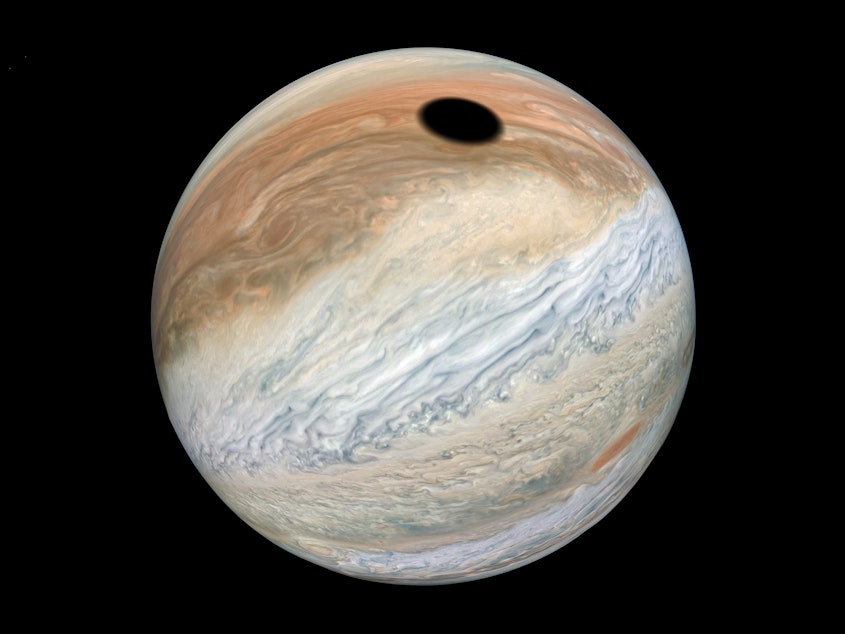Here's why Jupiter's tally of moons keeps going up and up

Scientists have spotted 12 more moons around Jupiter, adding to an already-huge number that just seems to grow and grow.
There's so many moons around this gas giant planet that astronomer Scott Sheppard struggles to keep track.
"With this new haul, we're up to, I believe, 92 ... actually, I have to check that," he says, leaning over to type into his computer at the Carnegie Institution for Science, Earth and Planets Laboratory in Washington, DC. " Yeah, so 92 is the number that we have right now."
His team is currently tracking some more moons that, once confirmed over the next year or two, should put Jupiter over 100.
There's good reason to keep looking for more moons, Sheppard says: If one was found in a convenient orbit, a spacecraft on a mission to Jupiter could fly close by and take a peek, letting scientists figure out what the moonlet is made of.
Sponsored
That's important because Jupiter's small, outer moons are fairly mysterious. Astronomers suspect that they are remnants of the original building material that got used to form the solar system's biggest planet.
Sheppard has been discovering new moons around Jupiter for over two decades, leading some colleagues to jokingly call him "Galileo," after the famous astronomer who first discovered that Jupiter had moons in 1610.
Every few years, Sheppard and his fellow astronomers take advantage of better technology and bigger telescopes to add more moons to the tally. At the moment, Jupiter holds the record for the most known moons, beating out Saturn, which has 83.
Unlike the four large "Galilean" moons, which have some dramatic features like volcanoes and subsurface oceans, the ones that Sheppard finds are tiny and orbit far out.
A "moon" is defined as an object that orbits a planet, he says, but beyond that, astronomers haven't really discussed how big an object has to be to count.
Sponsored
"The one thing I would say is that the International Astronomical Union has decided that they're not going to name any moon smaller than about 1 kilometer in size," he says.
Some of the moons he's discovered around Jupiter are about that size — a person could walk across them in around twelve minutes. From Earth, these little moons look like flecks of light.
"These objects are kind of jaggedy-edged, elongated-type objects, with probably many craters on their surface," he says.
They likely are fragments or shards of what was once a bigger object. The way these moons move around Jupiter in clusters suggests that each cluster is the remains of what was once a larger moon.
"We think that originally there were only a handful of parent moons that have been bombarded by either other moons or comets over the age of the solar system and have broken apart," he says.
Sponsored
Where those original moons came from, however, isn't clear. "These outer moons, we believe, were not formed with the planet. We think the planet captured them," says Sheppard.
The more moons he finds, the more likely it is that one will be in or near the path of a space probe headed to Jupiter.
Several spacecraft will soon venture out there to study the planet's larger, icy moons, which orbit closer to the planet. The European Space Agency's JUICE mission is scheduled to launch in April, and next year NASA is sending a probe to Europa.
One of the strangest moons found around Jupiter, and Sheppard's personal favorite, is a little oddball that travels without any companions.
"It's orbiting really far from the planet and it's in the region where everybody else is going the opposite direction. So it's kind of driving against the traffic," says Marina Brozovic, a physicist at NASA's Jet Propulsion Laboratory, who calculates the orbits of the outer moons.
Sponsored
She points out that Saturn's moon count keeps going up, too. After a bunch of new Saturn moons were announced in 2019, it took the record for the most known moons from Jupiter. Now Jupiter once again holds the title.
"It's kind of this little race between Jupiter and Saturn: who has more moons?" says Brozovic, noting that some researchers recently did a theoretical study which found that Saturn should ultimately have more, because of a recent collision that likely created a cascade of shards.
Between Jupiter and Saturn, she says, there's probably hundreds more moons waiting to be discovered. And Uranus and Neptune surely have undetected outer moons, too. But they're so far away, it's hard to see them.
Sheppard says that he and his colleagues have searched for little, unnoticed moons around other planets, like Mars and Venus — without finding any — and they're planning to search around Mercury in the coming months.
"We just finished doing Uranus and Neptune," he says. "So stay tuned. Some interesting things might come out of that in the future." [Copyright 2023 NPR]



